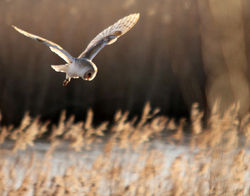Worcester & Malvern RSPB: Barn Owls
The Barn Owl is one of our most distinctive birds, instantly recognisable by its heart-shaped face and pure white underside. The Worcester and Malvern RSPB local group is working hard to help our local barn owl population. Simon Evans, the group’s Secretary, tells us what they are doing.
Coming across an Otter, Badger or Barn Owl in our countryside is a memorable event for me. Fortunately, these sightings are becoming more frequent. Otters can now be seen in the daytime along the River Severn in Worcester. Badgers are doing well and like Foxes are moving into the outskirts of urban areas.
Barn Owls, too, are becoming a success story. Like all wildlife they require food, shelter, and a place to breed. Conservation groups nationwide have worked hard to enhance all of these factors. Barn owls need to hunt in unkempt areas of long grass, riverbanks, hedgerows, and field margins. Initiatives encouraging farmers to expand such spaces, along with the trend towards rewilding and nature reserve creation, have played crucial roles in this success.
The provision of specialist nestboxes has also helped Barn Owls a great deal. Their traditional nesting sites in farmer’s outbuildings and sheds are diminishing due to farm consolidations and modern methods of agriculture. The old decaying trees that can also provide nest sites are sadly often removed from our countryside these days in the name of tidiness. It has been estimated that approximately 75% of the barn owl population now use nestboxes. The UK Barn Owl population, once stood at 12,000 pairs in the 1930s, it dipped to 4,000 in the 1980s, but may now have rebounded to 14,000.
The Worcester and Malvern RSPB Group is playing a part in this success. One of our members, Stuart Brown, has long been involved in monitoring Barn Owl nests and ringing their chicks. Through the Wild Isles crowdfunding appeal, our group has been able to build on this. Thirty nest box kits were cut out from plywood and taken away to be assembled by members after a training session. These boxes are now being installed in suitable locations across the local countryside, by some of our more agile members who have been trained to work at heights.
The group is also helping Barn Owls in other ways. We are collaborating with Malvern Hills District Council to restore a flood meadow habitat along 14 Hectares of land alongside the River Severn near Hallow. This will benefit many species, including Barn Owls. Our group is also engaging with local schools. This includes conducting a very popular owl pellet dissection with the children, followed by a short talk. We can create a lasting legacy by fostering a love of nature and our wildlife.
If you are interested in becoming a member of our group, becoming a volunteer on our many projects, or are a landowner with an interest in enhancing the natural aspects of your land, please contact Catherine Lees, membership secretary, by emailing clees21@outlook.com


